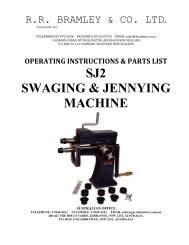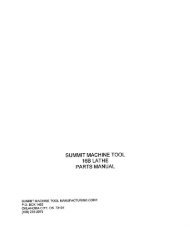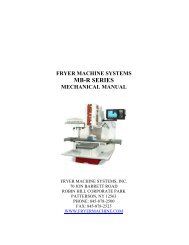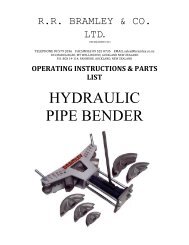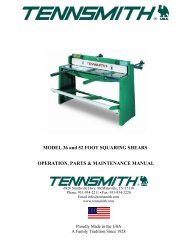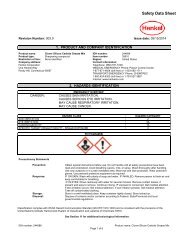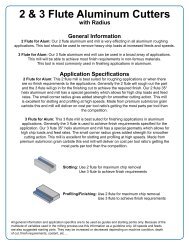operation, parts & maintenance manual models hbu48-16 hbs48-16
operation, parts & maintenance manual models hbu48-16 hbs48-16
operation, parts & maintenance manual models hbu48-16 hbs48-16
Create successful ePaper yourself
Turn your PDF publications into a flip-book with our unique Google optimized e-Paper software.
OPERATION, PARTS & MAINTENANCE MANUALMODELS HBU48-<strong>16</strong> HBS48-<strong>16</strong>6926 Smithville Hwy. McMinnville, TN 37110Phone: 931-934-2211 • Fax: 931-934-2220Email info@tennsmith.comwww.tennsmith.comProudly Made in the USAA Family Tradition Since 1928
FOREWORDThis <strong>manual</strong> has been prepared for the owner and operators of Tennsmith HBU48-<strong>16</strong> and HBS48-<strong>16</strong>model bench brakes. Its purpose, aside from <strong>operation</strong>s instructions, is to promote safety through the useof accepted operating procedures. Read all instructions thoroughly before operating the brake.Also contained in this <strong>manual</strong> is the <strong>parts</strong> list for your brake. It is recommended that only Tennsmith orfactory authorized <strong>parts</strong> be used as replacements.WARRANTYYour brake has a three year limited warranty from the date of purchase. The terms of the warranty arestated on the warranty registration card shipped with your machine. Please complete and return this cardto activate your warranty.SAFETY INSTRUCTIONS1. Know the safety and operating instructions contained in this brochure. Become familiar with andunderstand the limitations of this machine. Always practice safety.2. Wear approved eye safety protection such ass glasses, goggles, etc., when operating the brake toprotect your eyes.3. Wear protective foot wear or safety shoes.4. Keep your hands clear of the nose bar and clamping area of the brake. Keep hands clear of theapron area of the brake when making bends.5. When bending capacity material use your legs and arms for making the bend, similar to lifting aheavy object, to avoid back strain. Maximum length and capacity material is a two person job.Adjust the counterweights to provide maximum assistance on heavy bends.6. Never use a pipe or bar on the clamp handles or apron handles for additional leverage.7. Keep clear of the counterweight apron swing area while operating the brake.8. Keep the work area around the brake clear and clean to avoid slipping or tripping.RECEIVING THE BRAKEUpon receipt, closely examine the brake for damage during shipment. Report to your distributor anydamage that may have occurred during transit.USE CAUTION IN HANDLING AND MOVING THIS BRAKE. Please note that brake is top heavy. Lift thebrake only from the ends as it is top heavy. Approximate weights for the respective <strong>models</strong> are as follows:HBU48-<strong>16</strong> 495lbs / 224.4 kg HBS48-<strong>16</strong> 460lbs / 208.7 kg3
ADJUSTING THE CLAMPING PRESURE: The clamping pressure should be adjusted according to thethickness of the material being worked. A common cause of forming problems is the result of eitherinadequate or excessive clamping pressure. Too much clamping pressure on one or both handlestypically will result in over bending the material on that particular end or relative to the center portion of thebrake. Not enough clamping pressure force will allow the material to slip during the bending process andresult in an under bent section. This under bending is often encountered in the center of the brake.Clamping pressure should be enough to hold the material securely in place but not so great as to requireundue effort in locking the clamp handles. Clamping pressure on the ends of the brake is adjusted byturning the nuts (84) on the threaded rod portion of the yoke assembly (907) which is below the clampswivel (78). The lift of the hold down assembly is adjusted by turning the nut above the clamp swivel.When the clamping pressure is properly adjusted, lock the nuts against the clamp swivel to prevent anychange in adjustment.HBU48-<strong>16</strong> BOX AND PAN BENDING: The fingers can be removed and repositioned on the hold downassembly by moving the clamp handle fully to the rear and loosening the finger clamp screws. Repositionthe fingers to assemble the desired width and secure the fingers to the hold down by tightening the fingerclamp screws. Be certain that the tops of the fingers are flush and parallel with the milled edge on the holddown and the finger clamps are parallel with the bottom edge of the hold down. As a general rule, use thewider finger first and fill in with the narrower fingers. Small gaps between the fingers may be left with noadverse effect to the work piece. The maximum depth of box or pan which can be bent is 4-Inches.COUNTERWEIGHT ALIGNMENT: The counterweight on this brake can be adjusted to balance the apronfoe ease of <strong>operation</strong>. Loosen the set screws and raise or lower the counterweight to achieve the desireddegree of balance. Be certain to re-tighten the set screws thus securing the counterweight in place.HEMMING:Note: Forming hems is a secondary <strong>operation</strong> for a hand brake. If you adjust the brake to close a hemin the center of the work piece, the brake most likely will not bend straight. A hem is formed by making anacute (reverse) bend in the work piece and then clamping the bent flange in the hold down (1) to press theflange closed (to 180 degrees). Often the hem will not fully close in the center of a long work piece due tofact that the outer ends of the brake are more rigid than the center. Here it is especially important that thebrake is sufficiently crowned and that there is proper clamping pressure at the center of the brake. Also thesituation can be improved by inserting a strip of material (of the same thickness as the work piece)between the work piece and the clamp block slightly longer than the open portion of the hem. Re-clampthe hold down to close the hem. A tinner’s mallet or hammer is also useful for closing hems. Be cautiousnot to use excessive force on the clamp handles to close the hem.ADJUSTING THE BRAKEWhen your brake was assembled at the factory it was adjusted for proper <strong>operation</strong>. Due to handling andrepositioning, the brake my require adjustment and alignment. Read the adjustment and operatinginstructions completely before making any adjustments. Operate the brake and bend some material firstbefore attempting any major adjustments.BASIC ALIGNMENT: The clamp block on the base of the brake should be straight. This is the referencepoint for all of the other alignment <strong>operation</strong>s in adjusting the brake. Raise or lower the center of the brakeby adjusting the center of the brake by adjusting the center truss rod. NOTE: Your brake has four trussrods which facilitate adjustment of the brake’s three primary weldments. Adjustments are accomplishedthrough rotation of the nut located on the studs mounted perpendicular to the weldments.5
HOLD DOWN ALIGNMENT: The forward edge of the fingers / nose bar on the hold down assemblyshould be even and parallel to the edge of the clamp block on the base. Release any clamping pressureon the hold down assembly by pushing the clamp handles slightly to the rear. Loosen the set screwlocated on each end of the hold down assembly and turn the eccentric to move the forward edge of theclamp block. Check to see that the edge of the hold down is flush with the edge of the block throughout theentire length of the brake. The central portion of the hold down assembly can be adjusted forward /backward and up or down via truss rod adjustment.OVERBENDING: The hold down assembly should be moved back on the end where the over bendingoccurs by slightly unclamping the clamp handles, loosening the set screw and turning the eccentric pin.When the correction is made retighten the set screw.PRECAUTIONSDO NOT USE THE BRAKE TO BEND RODS, NAILS OR WIRE. THIS WILL CAUSE DAMAGE TO THEEDGE OF THE NOSE BAR AND APRON.ALWAYS ADJUST THE CLEARANCE AND CLAMPING PRESSURE FOR DIFFERENT THICKNESSESOF MATERIAL.DO NOT EXCEED THE CAPACITY OF THE BRAKE. MAKE CERTAIN THAT APRON SUPPORT ANGLEAND APRON INSERT IS ATTACHED TO THE APRON ASSEMBLY WHEN MAKING CAPACITY BENDS.OTHERWISE PERMANENT DAMAGE TO THE APRON MAY RESULT.DO NOT bend seams, hems of locks unless the material is notched or the clearance is adjusted to doublethe seam/hem thickness. The capacity of this brake is <strong>16</strong> gauge (0.063). Multiple layers of material whichexceed this dimension are beyond the capacity of the brake.DO NOT USE PIPE EXTENSIONS TO GAIN ADDITIONAL LEVERAGE ON THE CLAMP HANDLES.ALWAYS USE MATERIAL WITH SQUARE SHEARED EDGES FOR BEST RESULTS. ROLLED EDGES,BENT OR WARPED MATERIAL WILL CUASE THE MATERIAL TO BOW WHEN BENT. KEEP SHEARBLADES AND SLITTER KNIVES SHARP.ALWAYS BEND SHORT PIECES OF MATERIAL IN THE CENTER OF THE BRAKE IN ORDER TOEQUALIZE THE STRESS.ORDERING PARTSWhen ordering <strong>parts</strong> please furnish both the model and serial number of your machine. Part’s can beobtained directly from Tennsmith Inc.6
Bench Model Bending Brakes SpecificationModels HBU48-<strong>16</strong> HBS48-<strong>16</strong>Capacity, mild steel <strong>16</strong>ga / 1,6mm <strong>16</strong>ga / 1,6mmCapacity, bending supportangle removed20ga / 1,0mm20ga / 1,0mmBending length 48-1/4in / 1225mm 48-1/4in / 1225mmMaximum depth of box 4 in / 101.7 N/AMaximum lift of beam 1-1/4in / 31.75mm 1-3/4in / 44mmFront to rear adjustment 5/8in / <strong>16</strong>mm 5/8in / <strong>16</strong>mmMinimum reverse bend 1/4in / 6mm 1/4in / 6mmMinimum flangein capacity material1 in / 25 mm 1 in / 25 mmDimensions, LxWxHWeight 495 lbs / 224.5 kg 460 lbs / 208.7 kg6926 Smithville Hwy. McMinnville, TN 37110Phone: 931-934-2211 • Fax: 931-934-2200Email info@tennsmith.comwww.tennsmith.comProudly Made in the USAA Family Tradition Since 19287




